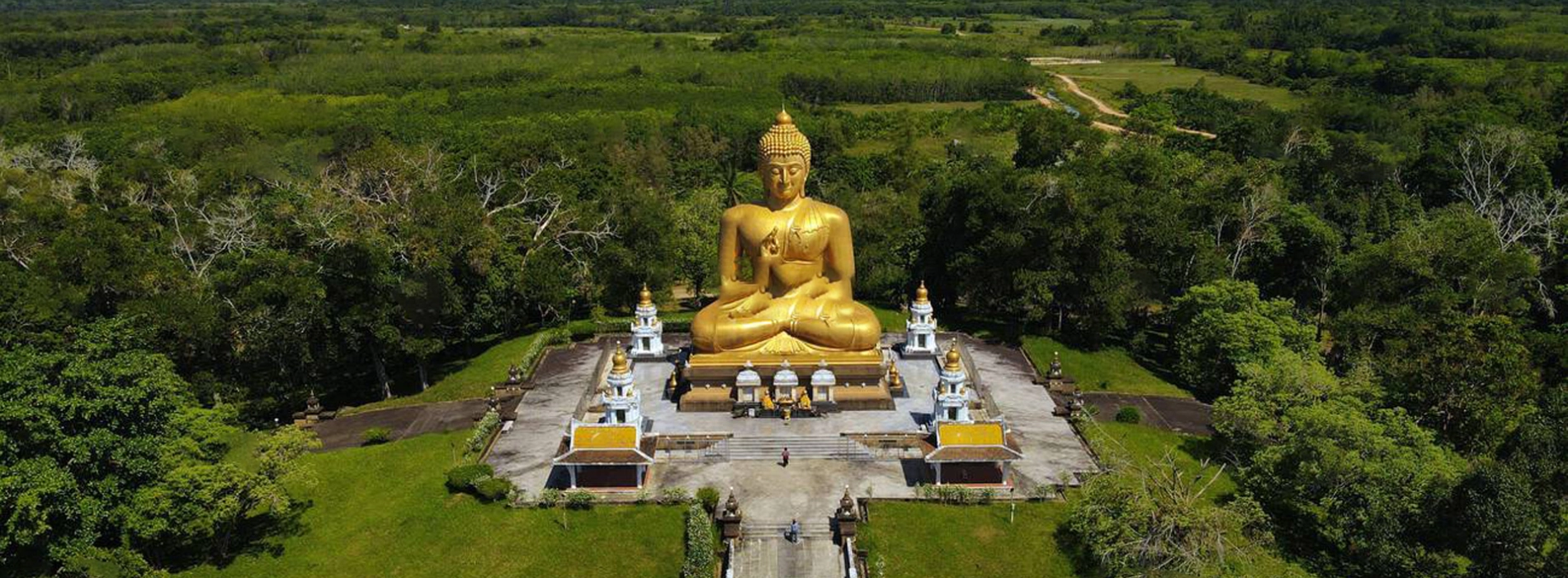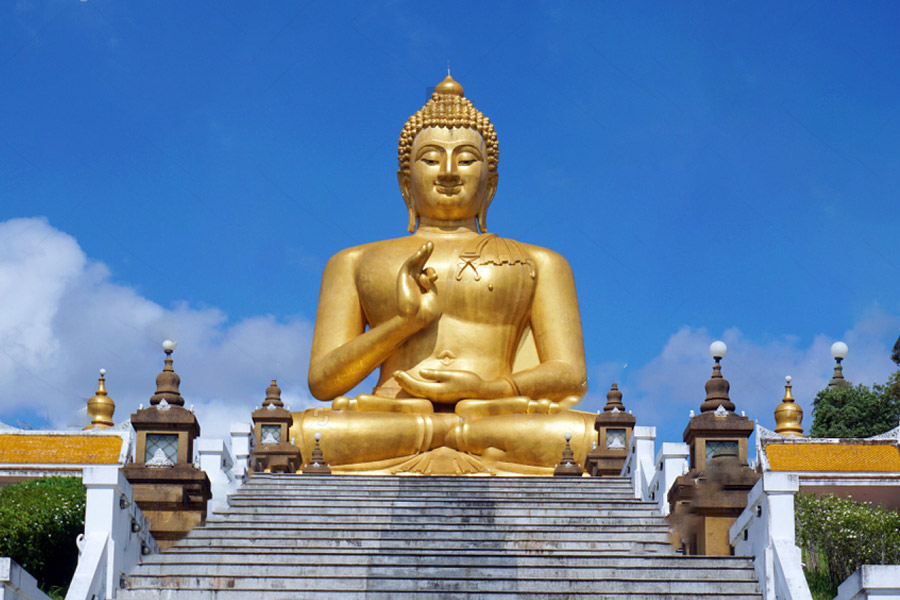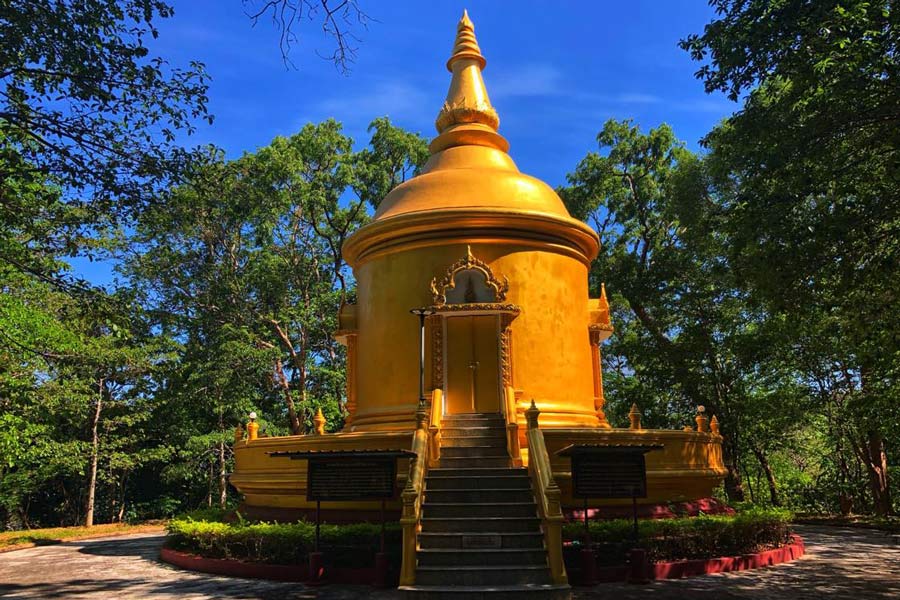Khao Kong Temple

Khao Kong Temple, commonly referred to as Wat Khao Kong, is a well-known spiritual and cultural location in Narathiwat Province, Thailand. Renowned for its serene surroundings and magnificent Buddhist architecture, the temple draws in guests looking for spiritual development and serenity.
Let's explore this captivating place with Asia King Travel!
Founded under King Rama V reign, Wat Khao Kong is located in the Lumphoo sub-district of Narathiwat Province. After being abandoned for a while, it was reopened in 1951 when monks moved back in.

About Khao Kong Temple (Alamy)
Phra Phuttha Thaksin Ming Mongkol, a beautiful Buddha statue built between 1966 and 1969 according to the Buddhist art style of southern Indian artisans, is the temple's most famous feature. During the 1970 opening ceremony, King Bhumibol Adulyadej of Thailand presided over the placing of the Buddha's relics in the statue.

About Khao Kong Temple (Shuttlestock)
Located barely 9 kilometers from Narathiwat town on Narathiwat-Lampura-Ngae Road, the temple sprawls across a space of roughly 227,200 square meters.
Designated as the Khao Kong Buddhist Park, this location offers a blend of historical and cultural treasures, including a bell-shaped Siri Maha Maya pagoda and a distinctive Buddhist temple styled like a prostate elephant bearing lotus blossoms.
Phra Phuttha Thaksin Ming Mongkol, the temple's centerpiece, is an awe-inspiring Buddha statue seated on a hilltop in the posture of giving his first sermon sitting cross-legged.
Constructed from reinforced concrete and steel, and adorned with golden mosaic tiles, the statue measures 17 meters in lap width and 24 meters in height, measured from the lotus stem to the lotus under the tiered umbrella.
The statue, facing the Gulf of Thailand, enshrines Buddha's relics which were brought from the four holy places of Buddhism and contained in its left chest.

Phra Phuttha Thaksin Ming Mongkol (Alamy)
It is a southern Indian artisan art in the Chola prevalent style in the southern and Malay areas. This characteristic of Buddha statue can be found abundantly in Nakhon Si Thammarat Province, so called "the style of Nakhorn Si Thammarat" or "Ka Nom Tom". The unique point is that Buddha's costume is very neat and his body figure is quite firm.
The Rian Phra Phuttha Thaksin Ming Mongkol is a revered medallion made from various sacred materials and blessed by prominent monks from Southern Thailand, such as Luang Pu Nak from Wat Rakang Kositaram, Ajarn Nong from Wat Sai Khao, Luang Phor Daeng from Wat Chern Kao, Ajarn Chum Chaikiri, etc.
Created in 1968, this medallion underwent numerous incantation ceremonies over time, making it valued for collectors and devotees seeking spiritual protection and good fortune.
According to the picture of the rian (medal), the copper rian was the first model. It consists of the small original circled ring at the top, its feature remains in good shape.

Rian Phra Phuttha Thaksin Ming Mongkol
While the metal melted to form the Rian (medal), the mystic symbols from Ajarn Tim from Wat Chang Hai, Chao Khun Seng from Wat Laem Sai, and Ajarn Num from Wat Donsala, were not able to be melted.
Therefore, they had to be brought back to perform a ceremony again before it could be melted. All the great masters from Wat Khao Or and other southern provinces participated in the ceremony. The price of this product is reasonable, so you can purchase it for collection.
Adjacent to the Buddha statue, the bell-shaped stupa of Siri Maha Maya is another significant highlight. The "Siri Maha Maya Chedi", a bell-shaped pagoda, is located on the hill next to the temple, above the arches of all 4 directions.
This intricately designed pagoda houses Buddha's relics and is surrounded by smaller pagodas. The temple's ubosot features beautifully carved terracotta tiles and depicts historical and religious scenes. There is a prostate elephant offering lotus flowers and a gable depicting a warrior, with an angel holding a jug as an offering.

The bell-shaped stupa of Siri Maha Maya
The dry season, which stretches from November to April, is the best time to visit Khao Kong Temple. These months have lovely weather that is ideal for taking part in outdoor activities and touring the temple grounds.
Steer clear of the monsoon season (May to October), since excessive rains might ruin your experience and cause travel plans to be disrupted.
Visiting Khao Kong Temple is affordable, with minimal costs involved:
Accommodation:
Budget guesthouses: $20 - $40 per night
Mid-range hotels: $50 - $100 per night
Luxury resorts: $120 - $250 per night
Food and Dining:
Local street food: $2 - $5 per meal
Meals at mid-range restaurants: $10 - $20 per person
Special seafood dishes at local restaurants: $20 - $40 per person
Transportation:
Taxi from Narathiwat town to Khao Kong Temple: $10 - $20
Local bus fare: $1 - $3
Minivan service (Narathiwat-Tanyong Mat route): $2 - $5
Bicycle rental: $5 - $10 per day
Motorbike rental: $10 - $15 per day
Entrance fee: Free (donations are appreciated)
Souvenirs and medallions: $5 - $20 per item
Khao Kong Temple is conveniently located 9 kilometers from Narathiwat town and open daily 06.30-17.30 hours. Here are the best ways to reach the temple:
By Air: Fly to Narathiwat Airport (NAW), then take a taxi or local bus for a 30-minute ride to the temple.
By Train: Take a train from Bangkok to Narathiwat, a journey that takes around 20 hours. From the Narathiwat train station, take a taxi or local bus to the temple.
By Bus: Buses from Bangkok and other major cities to Narathiwat take approximately 14 hours. Once at the Narathiwat bus terminal, local transportation options to the temple are readily available.
By Road: From Narathiwat central city, take Highway No. 4055 (Narathiwat-Ra-ngae route) for about 9 kilometers. The Khao Kong Buddhist Park will be on the right-hand side. A minivan service (Narathiwat-Tanyong Mat route) is also available and passes by the Buddhist Park.
Additionally, it is also accessible by taking route 4055, and it is roughly 6 kilometers from the city district and Ra Ngae district. The temple and Phra Phutta Thaksin Ming Mongkol are visible at the summit of the mountain near the 105-kilometer marker.
Maybe you are interested in